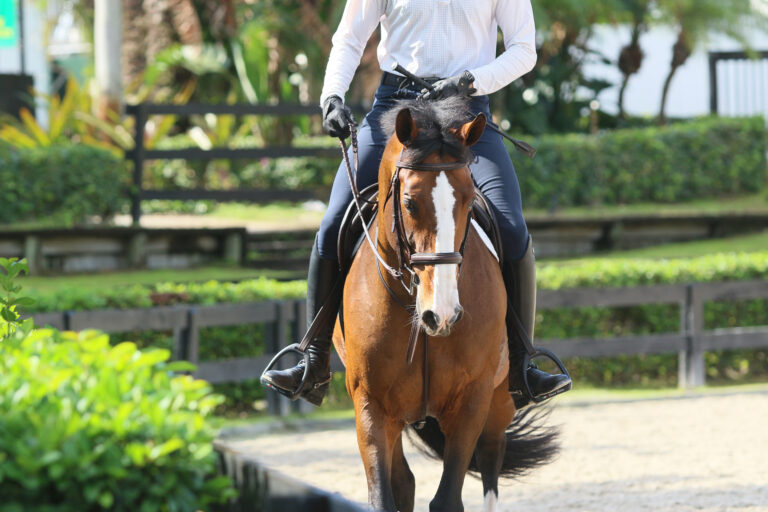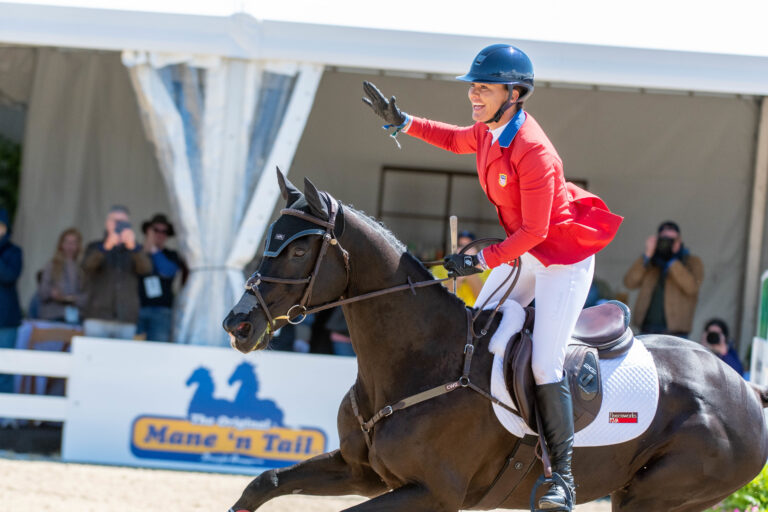“A happy horse will always be more successful than an unhappy one,” Olympic eventer Will Coleman said to the assembled riders, whose mounts ranged from an off-the-track Thoroughbred and a homebred Warmblood-cross to a PMU rescue horse and a Shetland Pony. “If you can get to a point where you feel like you give the horse a reason to come out and work for you every day, you’re always going to have a better chance of getting not only a better performance but a much more enjoyable and fulfilling performance.”
Coleman, who rode Twizzel on the 2012 Olympic eventing team, spoke about creating a willing partner in your horse through correct, sympathetic riding at a clinic for riders from Olney Farm in Joppa, Maryland. The farm had won the training session by earning the “Best Group Spirit Award” at last year’s Washington International Horse Show Barn Night, where enthusiastic equestrians from local stables show their pride. The clinic was courtesy of Cavalor and held at Shawan Downs in Cockeysville, Maryland, last spring.
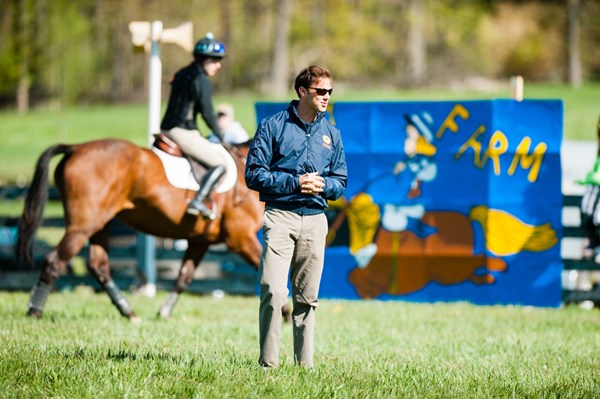
The 18 riders were split into four groups based on their level of riding, which ranged from Beginner Novice to Preliminary. All of the groups warmed up on the flat while Coleman observed before moving on to exercises over fences and a stadium course. The two more-advanced groups also schooled cross-country fences.
To make the most of their time, he encouraged participants to ride at the highest level of their ability, as though they were in a competition setting. Although he explained that the riders shouldn’t expect to fix all their issues in one clinic. “You’ll get some ideas and tips for how you can progress going forward,” he noted.
Read on for Coleman’s 10 ideas and tips to apply to your own training.
Be Fair, Be Clear
Throughout the clinic, the five-star eventer stressed the importance of being fair to your horse. To do this, he explained, you must be clear with your aids. If you are either too aggressive or too passive with your aids, you can’t expect the horse to understand what you’re asking of him. “Not being clear is not being fair,” he said.
When a rider was too sharp with her rein aids, Coleman explained that inconsistent, aggressive aids disrupt a smooth connection, causing confusion and discontent. “You give him one of those jawbreakers, it’s not clear to the horse,” he said. “Try to find more shades of gray in the aids.”
Likewise, aids that are too “quiet” for the horse to understand prevent clear communication. “Softness lends itself to being unclear sometimes,” Coleman said. “You can be sympathetic while still being clear.”
He cautioned against aids applied either accidentally or due to frustration. “You have to start from a place of non-interference on the horse. If aids are turned on inadvertently or without your expressly meaning to, it becomes detrimental to clear communication with the horse.”
Be Accountable
After observing one rider who had trouble staying mentally organized when riding on her own, Coleman explained the importance of accountability. “You need to self-coach. Instruction will only take you so far. You have to go into the ring and do it yourself.”
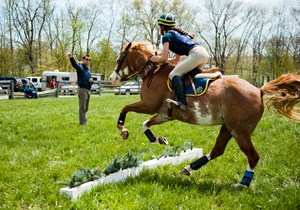
Part of being your own coach is being accountable for your riding, including mistakes. Coleman asked her to focus on planning her ride. “Whether it’s a missed jump, a missed distance, a stop or just not executing something perfectly, it’s important that you understand why it didn’t work out,” he said. “The more you start to recognize what you’re doing wrong after you make a mistake, the more you’ll start to recognize it before it happens and, hopefully, prevent it.”
Look Where You’re Going
During his initial evaluation, Coleman pointed out that several riders were not looking where they were going. This is often an issue of concentration, he said. When you aren’t focused on the job at hand, you stop looking. Over fences, it is crucial to look where you’re going. “The jump is the most important thing you need to be looking at. Look until a stride out then raise your eyes to look over it,” he said. “I’ve never seen a situation where looking down at the horse helps.”
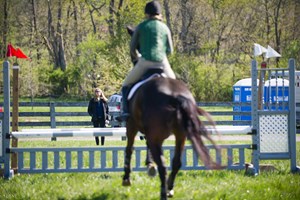
For a rider who looked down before the jump instead of looking at the jump, Coleman stood on the landing side of a flower box roughly 30 feet away and held up fingers. He asked the rider to tell him what number he was holding up as she approached and jumped the box. By providing a place to focus the rider’s eyes, he encouraged the rider to look up, pay attention and create a more balanced position. Once she developed the feeling of looking up, she was more able to look at the jump instead of down.
Ride an Excellent Approach
To help the riders focus on their approach to fences, Coleman set up a flower box on a circle. He instructed riders to pick up the canter, approach the flower box and count the strides to the box, which they would then jump, from eight strides away. The purpose was to set a line to the jump and to develop a steady rhythm and pace rather than becoming “infatuated with distance.”
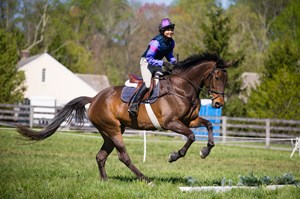
The simple exercise required riders to think about the flower box well ahead of time, discouraging them from making a last-second adjustment to their horses’ pace. “I know you’re looking at the jump at least eight strides away, which is enough time to keep rhythm,” Coleman said. “The distance comes out of the rhythm, so pick a rhythm and keep it consistent so you’re most likely to find a distance.”
Riders couldn’t be shy about counting loudly. Any riders who forgot to count audibly were told to drop their stirrups and trot around the large grass ring until their “tongue untied,” ensuring that they focused on being heard.
Although many of the approaches to the flower box ended on “six,” “seven” or even a few strides past “eight,” Coleman explained that the goal of the exercise was not to accurately predict the number of strides to a fence but to help riders focus on riding an accurate line with consistent rhythm and pace. “I don’t get fussed about whether they get ‘seven’ or ‘ten’ or ‘eleven.’ The goal is that they’re thinking along those lines and that they commit to being a little bit ahead of the curve when it comes to approaching an obstacle.”
When the horses jumped smoothly, he made it clear that the result was due to an excellent approach and preparation for the flower box rather than the jumping effort itself. “The process was better,” he praised.
Use a Reference Point
During the second group of the day, Coleman had riders canter an approximately 30-meter circle on the left lead over a vertical several times. Some riders struggled to maintain a consistent size to their circles so they ended up making different approaches to the fence each time. This resulted in them rarely meeting the fence at an appropriate distance but instead alternately chipping in or leaving from a long spot.
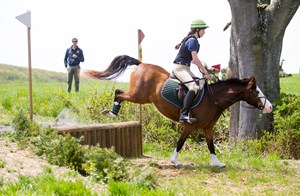
To encourage more focus on the circle, he stood about 30 feet away from the final turn to the fence and asked riders to use himself as point of reference. The incentive to avoid trampling him encouraged the riders to be exacting in the geometry of their circle, which resulted in a consistent approach to the fence.
A “human cone” was also used to help riders develop their horse’s attentiveness after a fence. He asked a volunteer from the auditors to stand 50 feet away from a small vertical on the landing side, centered with it. The riders were to trot to the fence, jump it and come to a walk before the volunteer. The impetus to not stampede the person compelled riders to focus on riding the downward transition effectively. After a few times walking after the fence, the horses became more attentive and willing to respond to the rider’s aids.
Coleman explained that he preferred riders to slow to a walk rather than a halt after a fence. A horse could associate a halt with punishment rather than as a test to see if he is listening. Halting could have an especially negative effect for sensitive horses, he added.
Let Your Horse Go
Some riders focused too intensely on dictating their horse’s every move, often losing sight of the task of jumping.
One rider on a more excitable horse excessively worked on getting him to become calmer. Coleman explained by paying so much attention to the horse’s behavior, she lost sight of the point of the exercise. “You’re trying to get him feeling just right,” he said. “You then miss the boat, which is the fence coming up right in front of you.”
He had the rider canter on a circle over a small vertical, asking her to pay attention to the approach rather than worrying about her horse. When she stopped making constant adjustments with her aids, her horse settled into a steadier canter. Another rider with a very obedient horse also adjusted her mount too much. On the approach to a Training-level brush jump, she adjusted her horse’s speed multiple times instead of developing a consistent rhythm. “Rideable horses can let the rider take the easy way out and encourage you to pick, pick, pick,” Coleman said.
By allowing her horse to keep one rhythm, the rider was rewarded with a smoother jump because she was able to focus on the jump instead of his speed.
Ride the Horse You’re On
One rider struggled with her sensitive horse who tended to back off from fences. As a result, she rode aggressively forward to all jumps. Coleman cautioned, “Be careful not to get myopic about what you’re feeling. When it’s always ‘attack, attack, attack,’ that can make a horse back off.”
He encouraged the rider to work with the horse she was on that day rather than assume he would always back off. If you assume too much, he explained, you might lose focus of what the horse needs that day or even at a particular fence.
Since the rider was using a driving seat at fences to push her horse into her hands, Coleman asked her to stay up off his back just for one jump, telling her, “Don’t create a strong horse when you don’t need one.” The result was a smoother approach and jump.
Warm Up for Success
During the ring sessions, many of Coleman’s jumping comments related to warming up correctly for the stadium phase. He asked riders to pay close attention to how their warm-up fences rode. “Your warm-up [jumps] are all clues,” he said. “I make my students jump very few jumps in the warm up, so they need to count. They jump no more than eight fences.”
When warming up a horse who tends to get strong before the stadium phase, he suggested riding one to two long, straight approaches to establish rhythm and then riding the rest of the warm-up jumps off a turn. Approaches off a turn allow the rider to ask the horse to wait more easily than off a straight approach, encouraging the horse to listen to the rider instead of barreling over the jump. “When you don’t like the distance you see, wait for the right one. That’s the beauty of jumping off a turn,” Coleman noted.
Some of the riders believed they had to correct jumping faults, whether the horse bulged to one side before the jump or wasn’t completely square over the fence. While he acknowledged the importance of improving a horse’s way of jumping at home, Coleman said that the show-jumping warm-up is not the time. A rider should not try to address these issues at the last minute at a competition, he said, where the goal is to leave the rails up. “Letting a horse jump the way he wants to jump gives him the best chance of jumping clean.”
Slow It Down
The atmosphere of the clinic brought out excitement in a few of the horses, resulting in some overly enthusiastic efforts over a single vertical Coleman had the riders jump early in the clinic to assess their form over fences.
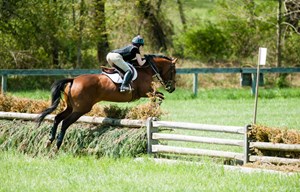
To help one rider develop better communication with her horse, he asked her to walk her mount over a small vertical while talking to her horse to help them both relax. “Slowing it down allows her to get to a place mentally where things aren’t happening so fast and she can hopefully try to find some peace with the horse,” he said.
After walking over the fence a few times, the rider trotted the fence (“not a dressage trot, just a piddly little trot,” Coleman said) until she was ready to attempt the fence at a relaxed canter. By jumping the fence at slower gaits, the rider was able to “realize maybe the jump didn’t need to be such a big event,” he said.
He explained that for many quick horses, he finds slowing down the jumping process to be successful, especially when riding courses. “Any horse I’ve got that is impulsive, I trot the course up to four feet,” he said. “It’s good for your balance and teaches you to wait in a gait that’s more controllable.”
After having riders work over single fences, Coleman set up a course, which more excitable horses trotted. “If you’re not at a place where a course can be done with precision and control, I mix in the trot.”
Once the horses were able to complete the course in a relaxed manner, he allowed riders to thoughtfully incorporate some canter. “Be very mindful about what jumps to canter,” he said. “You’re always getting him to think about coming back.”
Be Flexible with XC Rein Length
Following an initial session in the ring, the two more-advanced groups set out onto Shawan Downs’ cross-country course, which includes fences from Beginner Novice to Advanced. After warming up over some basic fences, one group jumped up and down a small bank. Coleman encouraged them to feel comfortable riding down the bank with longer reins. “I lengthen my reins 4 to 5 inches to give myself room to open my hip angle and sit behind,” he noted. “I want to feel like I let the horse jump out in front of my hips.”
He said lengthening his reins can be beneficial for horses who don’t back off at cross-country fences by creating a sense of independence that helps them to think more critically about what’s in front of them instead of looking to the rider for guidance. He acknowledged that while it’s harder to lengthen your reins on a stronger horse because you don’t want to release control, you can think about letting the jump hold the horse instead of holding the horse with your reins.
Coleman also stressed the safety component of being able to slip your reins. “Things can happen cross country, whether a horse can stumble on landing or running over terrain. The footing isn’t arena footing where it can be predictable,” he said. “You have to always be prepared for something to happen. As you watch any great rider cross country, when things go wrong a lot of times the first thing they do is slip their reins and get very much out of the horse’s way.” When a rider slips their reins in a dangerous situation, she allows the horse to regain balance on his own rather than interfering with his mouth.
Riders left the clinic with new insights and tools for clear and fair riding. This will help a rider earn ribbons in competition but, more importantly, it’s something horses deserve, Coleman said. “Horses are rewarded by good riding. I think they’ve earned that.”
This article originally appeared in the October 2014 issue of Practical Horseman.
Thanks to Mane ‘n Tail for our coverage of the 2024 Maryland 5 Star at Fair Hill, including rider interviews, competition reports, horse spotlights, photos, videos and more






